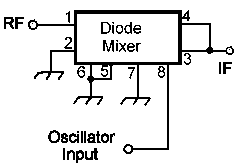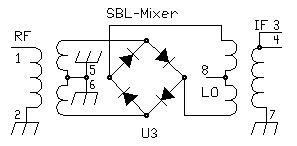



|
The first mixer of the Super Receiver is homebrewed. The coils are wound on FT50-43 ferrite cores with 1N914's for the diodes. The 1N914's have been changed to pin diodes and there was no detectable difference in performance. FT37-43 ferrite cores also work fine. The QRP Homebuilder site has an excellent page on how to build a diode mixer at http://www.qrp.pops.net/xmfr.asp. How to wind the trifilar coils is presented in great detail for those that need help. The Low-pass filter was added to clean up the VFO signal. Since there are two MOSFET amplifiers, plus a 2N5109 amplifier, the harmonics were very strong. When viewed on an oscilloscope, a sine wave could not even be seen. With the Low-pass filter, a beautiful sine wave is seen on the oscilloscope. The clean VFO signal helps keep birdies out of the receiver and helps with phase noise, etc. Wire size #24 or #22 can be used for the windings. T50-6 cores were used. The capacitors were split for no other reason than to achieve the values needed. Any combination can be used, just arrive at the same total values for each set. Commercial Mixer  An SBL-3 diode mixer can be substituted for the homebrew mixer. The SBL-3 is a level 7 mixer, requires +7dBm LO, up to +1dBm RF. Conversion loss is approximately 4.63 dB at 10 MHz. (From Mini-Circuits data sheet 00-88) When using a Level 7 mixer, the 2N5109 amplifier is not needed. The output of the two MOSFETs are +7dBm. Another combination is to use one MOSFET amplifier, and one 2N5109 amplifier. It is important to use a high impedance amplifier after the VFO so it is immune to load changes. The 2N5109 with a 3dB pad sets the correct input impedance for a diode mixer (50 ohms). Also check out the Progressive Communications Receiver for another VFO amplifier chain that works well with a Level 7 mixer. ReferencesAn excellent discussion of diplexers for terminating diode mixers is at Diplexers For Superheterodyne and Direct Conversion Receivers. He has a basic circuit with formulas for determining component values. A Spice analysis using the Spiceage program is at http://www.spiceage.com/Spiceage/diodmixx.htm. A very good description of how the diode mixer works is at http://www.hp.woodshot.com/hprfhelp/4_downld/lit/diodelit/an995.pdf For an inside look at a SBL-1 including all the specifications, check out "My Homemade 20m SSB Transceiver". A application note that covers all the applications of the diode mixer can be found at http://rfwireless.rell.com/pdfs/AN_MixerApps.pdf |

Send E-Mail || Amateur Radio Receivers || Super Receiver || Super Receiver Circuit Details

